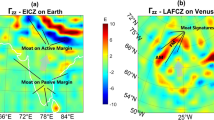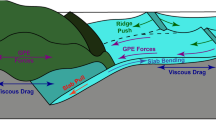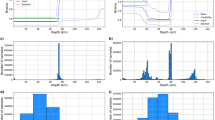Abstract
THE analysis of triple junctions (points on the Earth where three lithospheric plates meet) has proved to be a powerful tool in deciphering the plate tectonic evolution of the Earth. In their classic paper on the evolution of triple junctions1, McKenzie and Morgan dismissed the possibility of stable quadruple junctions existing more than instantaneously. We show here that quadruple junctions can be stable according to the vector velocity stability criteria of McKenzie and Morgan.
This is a preview of subscription content, access via your institution
Access options
Subscribe to this journal
Receive 51 print issues and online access
$199.00 per year
only $3.90 per issue
Buy this article
- Purchase on Springer Link
- Instant access to full article PDF
Prices may be subject to local taxes which are calculated during checkout
Similar content being viewed by others
References
McKenzie, D. P. & Morgan, W. J. Nature 224, 125 (1969).
York, D. Nature 244, 341 (1973).
York, D. Can. J. Earth Sci. 12, 516 (1975).
Author information
Authors and Affiliations
Rights and permissions
About this article
Cite this article
HEY, R., MlLHOLLAND, P. Stability of quadruple junctions. Nature 277, 201–202 (1979). https://doi.org/10.1038/277201a0
Received:
Accepted:
Issue Date:
DOI: https://doi.org/10.1038/277201a0
Comments
By submitting a comment you agree to abide by our Terms and Community Guidelines. If you find something abusive or that does not comply with our terms or guidelines please flag it as inappropriate.



